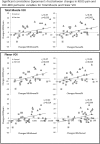Exercise-induced pain changes associate with changes in muscle perfusion in knee osteoarthritis: exploratory outcome analyses of a randomised controlled trial
- PMID: 31656173
- PMCID: PMC6815355
- DOI: 10.1186/s12891-019-2858-8
Exercise-induced pain changes associate with changes in muscle perfusion in knee osteoarthritis: exploratory outcome analyses of a randomised controlled trial
Abstract
Background: Exercise therapy is recommended for knee osteoarthritis (OA), but the underlying mechanisms of pain relief are not fully understood. The purpose of this study was to explore the effects of exercise on muscle perfusion assessed by dynamic contrast enhanced MRI (DCE-MRI) and its association with changes in pain in patients with knee OA.
Methods: Exploratory outcome analyses of a randomised controlled study with per-protocol analyses ( ClinicalTrials.gov : NCT01545258) performed at an outpatient clinic at a public hospital in Denmark. We compared 12 weeks of supervised exercise therapy 3 times per week (ET) with a no attention control group (CG). Analyses of covariance (ANCOVA) were used to assess group mean differences in changes from baseline to week 12 in knee muscle perfusion quantified by DCE-MRI, patient-reported pain and function using the Knee Injury and Osteoarthritis Outcome Score (KOOS) questionnaire, knee extensor and flexor muscle strength tests, and the six-minute walking test (6MWT). Spearman's correlation coefficients were used to determine the correlation between changes in DCE-MRI variables, KOOS, muscle strength, and 6MWT. The potential effect mediation of the DCE-MRI perfusion variables was investigated in a post-hoc mediation analysis.
Results: Of 60 participants randomised with knee osteoarthritis, 33 (ET, n = 16, CG, n = 17) adhered to the protocol and had complete DCE-MRI data. At follow-up, there were significant group differences in muscle perfusion changes and clinically relevant group differences in KOOS pain changes (10.7, 95% CI 3.3 to 18.1, P = 0.006) in favor of ET. There were no significant between-group differences on muscle strength and function. The changes in pain and muscle perfusion were significantly correlated (highest Spearman's rho = 0.42, P = 0.014). The mediation analyses were generally not statistically significant.
Conclusion: The pain-reducing effects of a 12-week exercise program are associated with changes in knee muscle perfusion quantified by DCE-MRI in individuals with knee OA, but whether the effects are mediated by muscle perfusion changes remains unclear.
Trial registration: ClinicalTrials.gov: NCT01545258 , first posted March 6, 2012.
Keywords: Exercise; Muscle perfusion; Osteoarthritis; Pain.
Conflict of interest statement
MB is chairman of the medical and scientific board, Image Analysis Ltd., London, UK and has stock options. He has received fees/honoraria (<$10,000) covering travel/accommodation costs as well as a small yearly honorarium. All other authors have nothing to declare.
RR and JDN: Consultants for Image Analysis Ltd. (analyses of MRIs and conventional radiographs).
Figures



References
-
- National Institute for H, Clinical E . Osteoarthritis: national clinical guideline for care and management in adults. London: NICE; 2014.
-
- Hochberg MC, Altman RD, April KT, Benkhalti M, Guyatt G, McGowan J, et al. American College of Rheumatology 2012 recommendations for the use of nonpharmacologic and pharmacologic therapies in osteoarthritis of the hand, hip, and knee. Arthritis Care Res. 2012;64(4):465–474. doi: 10.1002/acr.21596. - DOI - PubMed
Publication types
MeSH terms
Substances
Associated data
Grants and funding
LinkOut - more resources
Full Text Sources
Medical

